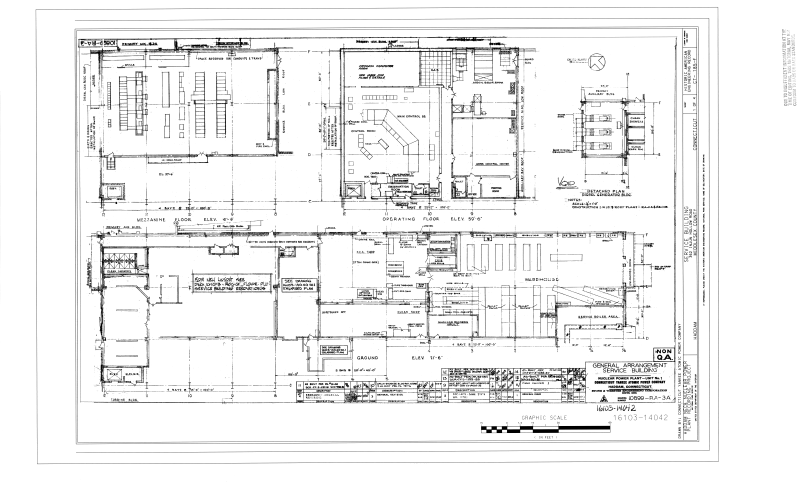General arrangement drawing
[edit] What are general arrangement drawings?
General arrangement drawings (GA’s) present the overall composition of an object such as a building. This is as opposed to more detailed drawings such as component drawings or assembly drawings that might only show a particular aspect or part of the object. General arrangement drawings show how the components fit together to create the whole.
Depending on the complexity of the building, they are likely to include a number of different projections, such as plans, sections and elevations, and the complete information may be spread across several different drawings. They may also be referred to as 'location drawings' as they show the location of various components and assemblies within the overall design, but this can be confused with location drawings indicating the geographical location of the building.
[edit] How are general arrangement drawings prepared?
General arrangement drawings are likely to be prepared at each stage of development of a design, showing the overall relationship between the main elements and the key dimensions. The level of detail will increase as the project progresses and they may need to be supplemented by more detailed drawings, showing specific elements and assemblies. On very simple projects these may be included on the general arrangement drawings themselves, but generally, separate drawings will be required. They can be very large drawings depending on the size and complexity of the obeject being represented and the scale used.
General arrangement drawings may include references to additional information, such as specifications and detail drawings, however they should not duplicate information included elsewhere as this can become contradictory and may cause confusion.
They may include notation, symbols, hatching and so on to indicate additional detail about particular elements. It is important that these are consistent with industry standards so that their precise meaning is clear and can be understood. For more information see: Symbols on architectural drawings.
They may also include other elements, such as a tile block indicating the drawing name and number, the creator of the drawing, the revision number, the scale, a north point and a key.
The scale at which drawings are prepared should reflect the level of detail of the information they are required to convey. Different line thicknesses can also be used to provide greater clarity for certain elements. For more information see: Scale in the construction industry.
General arrangement drawings may be drawn by hand, or prepared using Computer Aided Design (CAD) software. However, increasingly, building information modelling (BIM) is being used to create 3 dimensional representations of buildings and their components. General arrangement drawings can then be generated from the BIM model to the required scale.
BS EN ISO 7519:1997 Technical drawings. Construction drawings. General principles of presentation for general arrangement and assembly drawings establishes the general principles of presentation to be applied to construction drawings for general arrangement and assembly. This standard compliments the ISO 128 series on technical drawings.
[edit] Related articles on Designing Buildings
- As-built drawings and record drawings.
- Assembly drawing.
- Building information modelling.
- Component drawing.
- Computer aided design.
- Design drawings.
- Detail drawing.
- Elevations.
- Engineering drawing.
- Installation drawings.
- Notation and symbols.
- Paper sizes.
- Production information.
- Projections.
- Scale drawing.
- Section drawing.
- Shop drawings.
- Specification.
- Technical drawing.
- Technical drawing pen sizes.
- Working drawing.
Featured articles and news
Government consultations for the summer of 2025
A year of Labour, past and present consultations on the environment, the built environment, training and tax.
CMA competitiveness probe of major housing developers
100 million affordable housing contributions committed with further consultation published.
Homes England supports Greencore Homes
42 new build affordable sustainable homes in Oxfordshire.
Zero carbon social housing: unlocking brownfield potential
Seven ZEDpod strategies for brownfield housing success.
CIOB report; a blueprint for SDGs and the built environment
Pairing the Sustainable Development Goals with projects.
Types, tests, standards and fires relating to external cladding
Brief descriptions with an extensive list of fires for review.
Latest Build UK Building Safety Regime explainer published
Key elements in one short, now updated document.
UKGBC launch the UK Climate Resilience Roadmap
First guidance of its kind on direct climate impacts for the built environment and how it can adapt.
CLC Health, Safety and Wellbeing Strategy 2025
Launched by the Minister for Industry to look at fatalities on site, improving mental health and other issues.
One of the most impressive Victorian architects. Book review.
Common Assessment Standard now with building safety
New CAS update now includes mandatory building safety questions.
RTPI leader to become new CIOB Chief Executive Officer
Dr Victoria Hills MRTPI, FICE to take over after Caroline Gumble’s departure.
Social and affordable housing, a long term plan for delivery
The “Delivering a Decade of Renewal for Social and Affordable Housing” strategy sets out future path.
A change to adoptive architecture
Effects of global weather warming on architectural detailing, material choice and human interaction.
The proposed publicly owned and backed subsidiary of Homes England, to facilitate new homes.
How big is the problem and what can we do to mitigate the effects?
Overheating guidance and tools for building designers
A number of cool guides to help with the heat.
The UK's Modern Industrial Strategy: A 10 year plan
Previous consultation criticism, current key elements and general support with some persisting reservations.
Building Safety Regulator reforms
New roles, new staff and a new fast track service pave the way for a single construction regulator.


























Comments
[edit] To make a comment about this article, or to suggest changes, click 'Add a comment' above. Separate your comments from any existing comments by inserting a horizontal line.